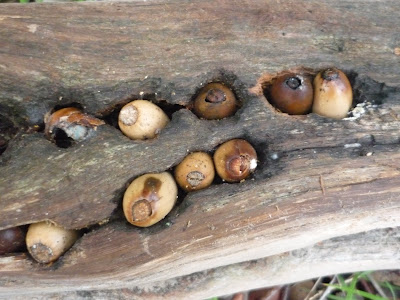Here's a list of birds I saw (or recognized) for the first time in 2009. It's kind of nice to look back on them, because most of them were spotted during a fun trip. It's a cool way to reminisce on the year's adventures:
Red-Throated Loon: April, Lake Merritt
Back in April, my sister and James called my attention to this bird--the first loon I'd ever seen. After evading our attempts to capture it in a laundry basket, the loon went on to nurse its illness under the storm drain.
Tundra Swan: December, Columnes
The swans also came with a quite juicy look at some Sandhill Cranes. I'm hoping this can be a yearly pilgrimage.
Spotted Sandpiper: June, South Lake Tahoe
A honeymoon bird!
California Gull: Lake Merrit
I've probably been seeing them for years, but my gull IDs are finally improving
Least Tern: September, Middle Harbor Park (Oakland Port)
 Common Murre
Common Murre: August, Tennessee Valley Beach
Another bird that I may have seen before but couldn't ID until now.
Clark's Nutcracker: June, South Lake Tahoe
The way Tom tells this story, it goes, "Lisa heard a bird calling, and she said, 'that sounds like a corvid, but not one I know,' and we walked over to the tree and there it was. Clark's Nutcracker."
Pygmy Nuthatch: April, Presidio
A side benefit of working out there is a quick chance to look for these every day. When I saw one for the first time, I thought, "what IS that? It's like a nuthatch, but TINY!"
Wrentit: August, Tennessee Valley Beach
I remember thinking, "It's like a giant bushtit." I'm proud of IDing this bird because it shows I am paying better attention to small, dull-colored birds that hide in bushes.
American Pipit: December, Sweetwater Reservoir, San Diego
Another steaky brown bird which I would have formerly ignored as a hopeless case.
Townsend's Warbler: February, my apartment
Tom spotted the yellow and black football helmet of this bird through our window. Considering that our view is of a parking lot with a single scrawny oak, this was a remarkable find.
 Wilson's Warbler
Wilson's Warbler: August, Tennessee Valley Beach
Song Sparrow: June, South Lake Tahoe
Another candidate for "brown streaky birds that formerly all looked the same to me."
Then there's all the birds I saw in Sicily this fall:Cormorant, Little Egret, Great White Egret, Grey Heron, Shelduck, Sparrowhawk, Golden Eagle, Kestrel, Oystercatcher, Redshank, Crag Martin, Pied Wagtail, (European) Robin, (European) Blackbird, Blackcap, Coal Tit, Great Tit, Nuthatch, Magpie, Jackdaw, Hooded Crow
 Next year, I'd like to add some more firsts! A few candidates:Pileated Woodpecker
Next year, I'd like to add some more firsts! A few candidates:Pileated WoodpeckerI have a lead on a park in Sonoma.
 Green Jay
Green JayIf I go to SE Texas on Vacation like I want to...
Grey Jay Another mountain trip sometime?
RoadrunnerWill this be the year?
Any ThrasherNext on the "Brown Bird" list
Any new WarblerMaybe I'll have better luck if I go to NY again...
All images came from the
NY Public Library Digital Archive, where I have taken years off my life just browsing the cigarette cards alone...
 Anyway, it turns out that although I did see a dark blob in the distance that MIGHT have been a pileated, that was the best view I ever got. On the other hand, I did see a coyote chasing a rabbit through a grape field.
Anyway, it turns out that although I did see a dark blob in the distance that MIGHT have been a pileated, that was the best view I ever got. On the other hand, I did see a coyote chasing a rabbit through a grape field. And plenty of nature's comedians, the acorn woodpeckers. People say that hyenas and kookaburras sound like they are laughing... I say the laughing animal of California is the acorn woodpecker.
And plenty of nature's comedians, the acorn woodpeckers. People say that hyenas and kookaburras sound like they are laughing... I say the laughing animal of California is the acorn woodpecker. Probably, they're laughing at squirrels who can't pry out their acorns and steal them. That's because acorn woodpeckers use their pecking powers to make holes in dead trees to wedge food for the winter. Just TRY to pull that out, squirrel...
Probably, they're laughing at squirrels who can't pry out their acorns and steal them. That's because acorn woodpeckers use their pecking powers to make holes in dead trees to wedge food for the winter. Just TRY to pull that out, squirrel... What was interesting about this particular population of acorn woodpeckers is that they had made several of their granary trees out of eucalyptus. Normally they use oak trees, but in this area that has a lot of vinyard and few oaks, the eucalyptic remnants of a failed timber speculation apparently make a pretty good substitute.
What was interesting about this particular population of acorn woodpeckers is that they had made several of their granary trees out of eucalyptus. Normally they use oak trees, but in this area that has a lot of vinyard and few oaks, the eucalyptic remnants of a failed timber speculation apparently make a pretty good substitute.





























